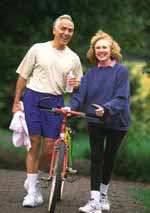Exercise
How Exercise Decreases Blood Sugar
 Most often, exercise lowers blood sugars. Exercise helps insulin to get more glucose from the blood and into the cells for energy. Blood sugars can get too low if your medication or insulin is working its hardest while you are exercising, or if blood sugar is on the low end of normal (below 100 mg/dl) before starting to exercise.
Most often, exercise lowers blood sugars. Exercise helps insulin to get more glucose from the blood and into the cells for energy. Blood sugars can get too low if your medication or insulin is working its hardest while you are exercising, or if blood sugar is on the low end of normal (below 100 mg/dl) before starting to exercise.
Preventing Low Blood Sugar After Exercise
Low blood sugar can occur up to 36 hours after exercise. This is because of increased insulin sensitivity and the fact that the muscles are pulling sugar from the blood to refuel.
- Prevent low blood sugar by testing your sugar before and after exercise. This helps you learn how your body reacts. If you are exercising for longer than 1 hour, you will want to check your blood sugar every 30-45 minutes during exercise.
- You may need a carbohydrate-containing snack before exercise if your blood sugar is below 100 mg/dl. Try 15 grams carbohydrate if you exercise for an hour. If you exercise for more than an hour, you may need to have 15 grams carbohydrate every 30 minutes while you exercise. How much to eat depends on your blood sugar before you exercise and how long and hard you will be exercising. The following are some ideas for snacks with about 15 grams carbohydrate:
- 3 graham cracker squares
- 1 small piece fresh fruit
- 4-6 snack crackers
- 2 tablespoons raisins
- 1-cup skim or low-fat milk
- You normally will not need an extra snack if you exercise 1-2 hours after a meal, when your blood sugars are the highest.
- Try to avoid exercising late at night. It may cause a low blood sugar reaction when you are sleeping.
- If you take oral medication to control your diabetes, do not make adjustments in the dosage without first discussing this with your health care team. With regular exercise and activity, you may be able to reduce your dose and perhaps even eliminate the need for medication altogether.
- If you take insulin, work with your diabetes healthcare team to learn how to adjust your dose if necessary.
- Sometimes insulin injection sites may need to be changed. Injecting into a muscle that will be exercising within 1-2 hours may burn off the insulin too quickly. Often a simple adjustment before the exercise occurs can prevent low blood sugars later on.
 How Exercise Increases Blood Sugar How Exercise Increases Blood Sugar
- If too little insulin is in the bloodstream during exercise, hyperglycemia can result.
- This may happen if you take insulin and exercise before injecting your morning dose.
- Some short, fast and hard workouts increase hormone levels. This may in turn raise blood sugars.
- In addition, pre-game jitters or the stress of competition may increase blood sugars.
These factors illustrate the necessity of blood glucose monitoring before and after exercise, so the proper adjustments can be made.
Precautions for Type 1 Diabetics to Follow Before Exercise
If your blood sugar is above 250 mg/dl it may be okay to exercise, but you need to take some precautions:
- Check your blood sugar before physical activity.
- If your blood sugar is above 250 mg/dl, check your urine for ketones. Type 1 diabetics spill ketones at different individual levels. It may be at 250 mg/dl for you, or it may be 280 or 300 mg/dl. Find out where this level is for you.
- If you have ketones, do not exercise. When you have ketones present, there is not enough insulin available to use up the sugar. If you were to exercise now your blood sugars would rise.
- Drink plenty of water.
- If you have an order from your doctor, you may need to take extra insulin.
- Recheck your blood sugar and urine again in 1-2 hours.
- If your blood sugar is still high and ketones are present notify your doctor.
Precautions for Type 2 Diabetics to Follow Before Exercise
- Type 2 patients normally do not spill ketones in their urine.
- If your blood sugars are high it may be due to a larger meal, stress or illness. Try to solve the puzzle as to why your sugars are high.
- If you exercise at the same time of day and your blood sugars are consistently high, notify your doctor. You may need a medication change.
- Be aware that if your blood sugars are high you may experience a large drop in your blood sugar level after exercise (for example from 400 mg/dl down to 200 mg/dl). You may feel like you are having a low blood sugar reaction. Check your blood sugar level. If it is below 100 mg/dl eat a snack. If it is above 150 mg/dl just rest until the feeling goes away.
As you can see, blood sugars can increase or decrease with exercise. Learn your body's response. Frequent glucose monitoring is the only way to learn how much your blood sugar will drop in response to exercise. This will help you to safely fit exercise into your day. Once you have a set exercise routine, you can predict your blood sugar response and will be able to check less often.
 Continue Continue 
|





